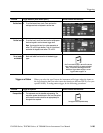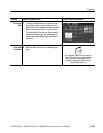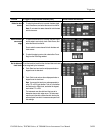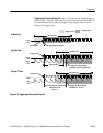
Triggering
CSA7000 Series, TDS7000 Series, & TDS6000 Series Instruments User Manual
3-113
Data (Ch1) transition occurs
within 14.88 ns after the
clock violating the hold time
limit.
The instrument recognizes
the violation and triggers at
the clock edge.
Cursors measure the
setup/hold violation zone
which equals setup time +
hold time (30 ns).
Figure 3- 27: Triggering on a Setup/Hold time violation
Sequential Triggering
In applications that involve two or more signals, you may be able to use
sequential triggering to capture more complex events. Sequential triggering uses
the A (Main) trigger to arm the trigger system, and then uses the B (Delayed)
trigger to trigger the instrument if a specific condition is met. You can choose
one of two trigger conditions:
H Trig After Time: After the A trigger arms the trigger system, the instrument
triggers on the next B-trigger event that occurs after the Trigger Delay Time.
You can set the trigger delay time with the keypad or the multipurpose
knobs.
H Trigger on n
th
Event: After the A trigger arms the trigger system, the
instrument triggers on the n
th
B event. You can set the number of B events
with the keypad or the multipurpose knobs.
NOTE. The traditional delayed trigger mode called “Runs After” is served by
Horizontal Delay. You can use horizontal delay to delay acquisition from any
trigger event, whether from the A (Main) trigger alone or from a sequential
trigger that uses both the A (Main) and B (Delayed) triggers. See Triggering
with Horizontal Delay On on page 3-- 116 for more information.


















